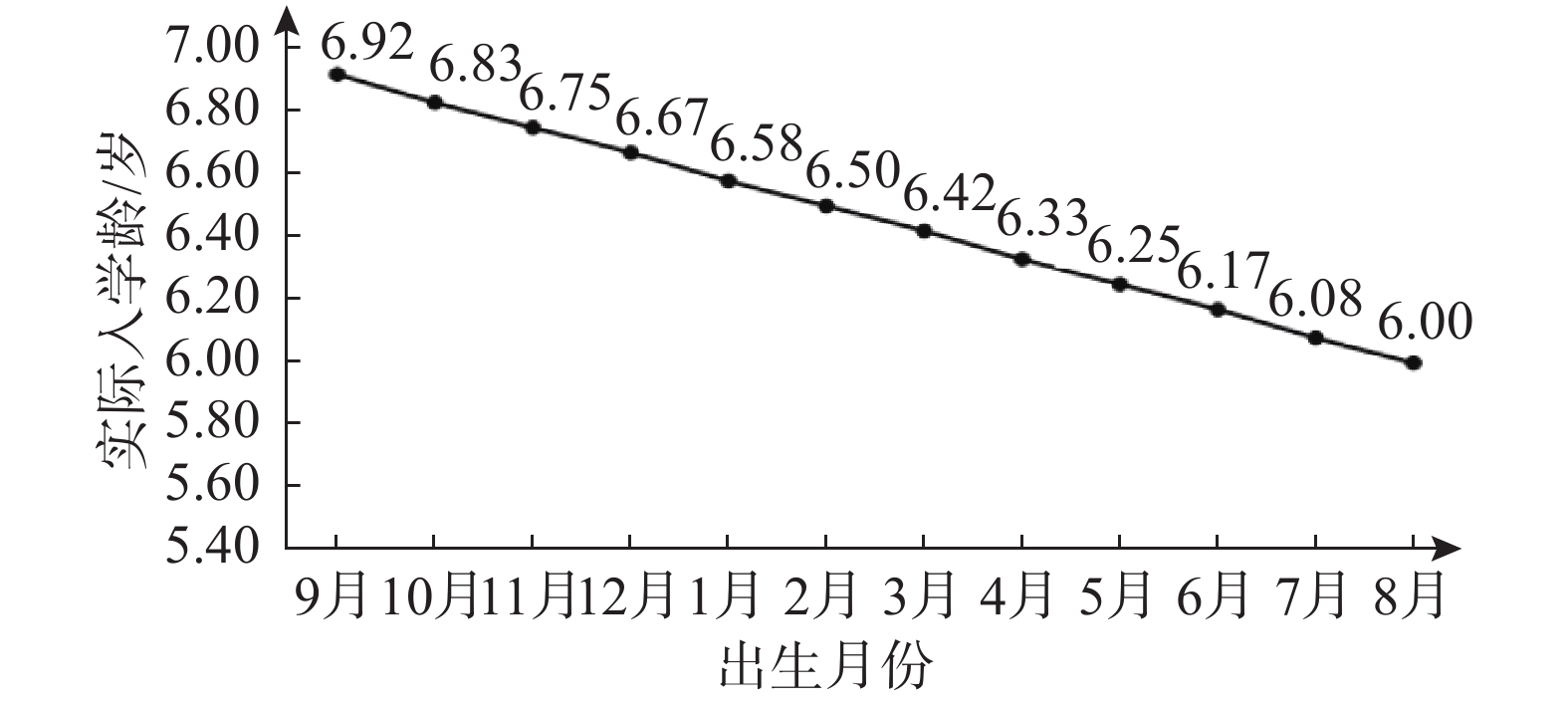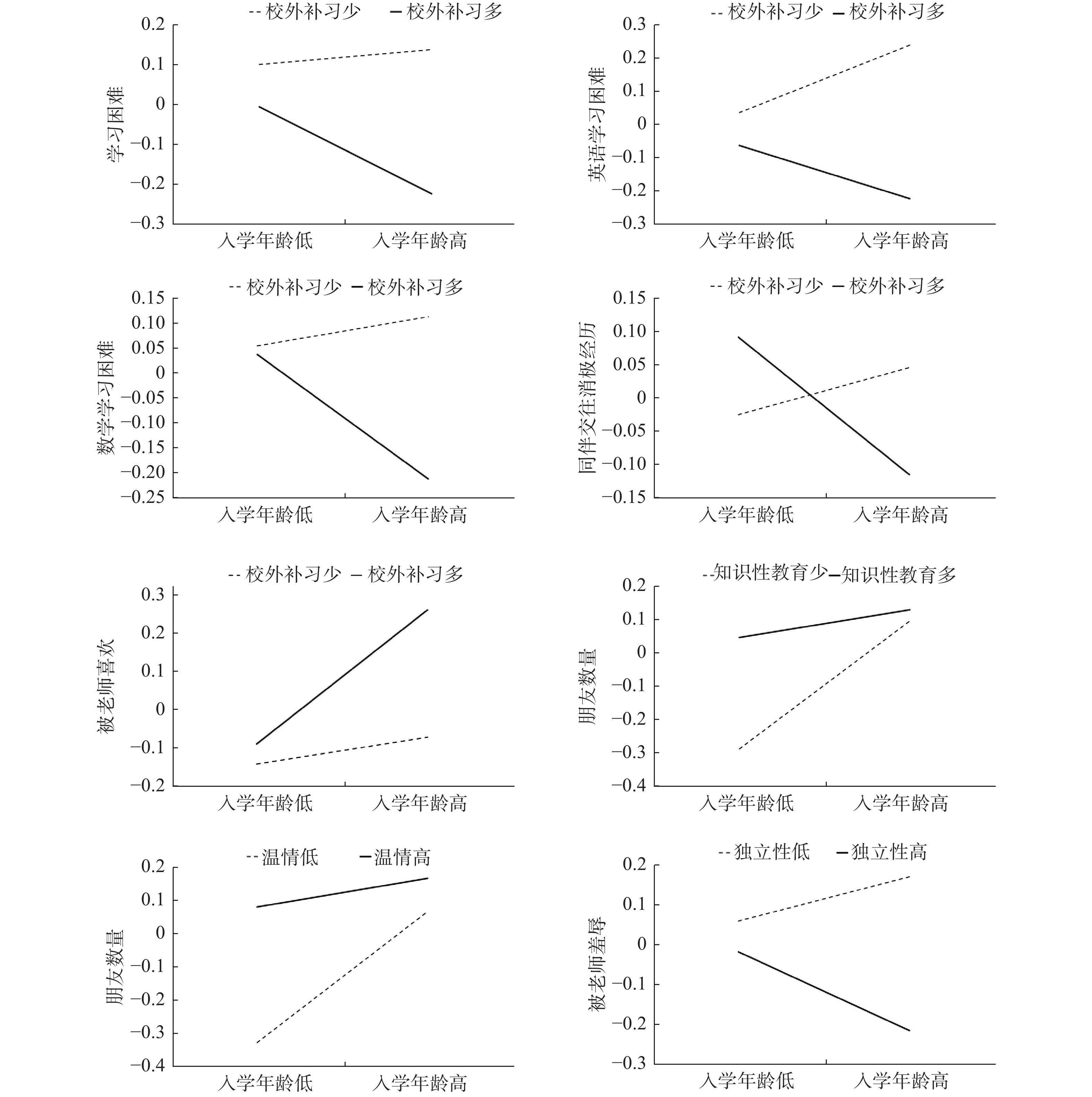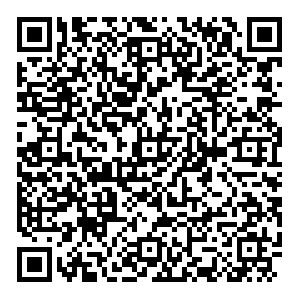The Effect of School Entrance Age on School Performance of Children and Adolescents in Compulsory Education
-
摘要: 在义务教育阶段,由于“入学年龄截止日期”的设定,导致了在同学年入学的儿童中,不同出生日期儿童的实际入学年龄不同。本研究利用上海市中小学生抽样调查数据,分析小学入学年龄对儿童学校表现的影响,探讨义务教育阶段的“相对年龄效应”。研究结果表明:小学阶段的相对年龄效应显著,直到初中后这一效应逐渐减弱甚至消失,但入学年龄对夏季生儿童的学校表现影响将从小学持续到初中;相对年龄效应对男女儿童的学习成绩均具显著影响,对女童的社会交往也具有显著影响;家庭资源对相对年龄效应具有调节作用。Abstract: In the stage of compulsory education, the actual school entrance age in the same school year is different due to the cut-off date for school admission. Based on the sample survey of primary and secondary school students in Shanghai, the effect of school entrance age on school performance was analyzed and the relative-age effect was discussed. The results showed that the relative-age effect in primary schools was significant, which gradually weakened or even disappeared after junior middle schools.But the school performance of summer-born children was more disadvantageous than those who were born in autumn from primary to the junior middle schools.The relative-age effect was significant on the academic achievement of both boys and girls, as well as on the social interaction of girls. Family resources can moderate the relative-age effect.
-
Key words:
- school entrance age /
- school performance /
- compulsory education /
- the relative-age effect
-
表 1 变量及其描述统计
变量 定义/赋值 平均值 标准差 1. 入学年龄 根据文中公式计算所得的小学一年级入学时的年龄。 6.46 0.30 秋季生组 出生于9、10、11月的儿童。 6.83 0.07 冬季生组 出生于12、1、2月的儿童。 6.58 0.07 春季生组 出生于3、4、5月的儿童。 6.34 0.07 夏季生组 出生于6、7、8月的儿童。 6.07 0.07 2. 学校表现 学习成绩 班级排名 1=最后五名;2=中下;3=中等;4=中上;5=前五名 3.49 0.96 学习困难 语、数、外等三门功课学习困难的均值。 2.32 0.68 语文学习困难 1=从不;2=很少;3=有时;4=经常 2.44 0.86 英语学习困难 1=从不;2=很少;3=有时;4=经常 2.24 0.95 数学学习困难 1=从不;2=很少;3=有时;4=经常 2.29 0.94 同伴关系 朋友/玩伴数量 1=1个也没有;2=1个;3=几个;4=十个以上 3.50 0.63 同伴交往消极经历 被同学取笑和忽视的程度。 1.71 0.79 被同学取笑 1=从不;2=很少;3=有时;4=经常 1.78 0.90 被同学忽视 1=从不;2=很少;3=有时;4=经常 1.64 0.88 师生关系 积极体验 被老师喜欢的程度。1=没有;……6=非常喜欢 3.86 1.68 消极体验 被老师羞辱的程度。1=没有;……6=极重 1.48 0.89 3. 个人特征 性别 0=女;1=男 0.47 0.50 学段 0=小学;1=初中 0.36 0.48 健康状况 最近半年有无生病。1=没有;……6=极重 1.72 1.13 4. 家庭资源 家庭社经地位 家庭收入、父亲学历和母亲学历等三项综合评定。 2.01 0.82 家庭收入 1=低收入(5000元及以下);2=中下收入(5001—8000元);3=中等收入(8001—1.5万元);4=中上收入(15001—2万元);5=高收入(超过2万元) 2.74 1.25 父亲学历 1=没有受过正式教育;2=小学;3=初中;4=高中或同等学历;
5=大专或高职;6=本科;7=硕士;8=博士4.69 1.37 母亲学历 1=没有受过正式教育;2=小学;3=初中;4=高中或同等学历;
5=大专或高职;6=本科;7=硕士;8=博士4.59 1.39 教育投入 校外补习情况 一周中的校外补习时间(小时)。 2.11 2.84 父母的知识性教育 父母与子女互动中的知识性传递。1=否;2=是 1.50 0.19 教养方式 温情 父母对于子女的情感支持及亲子之间的情感沟通。 1.55 0.28 控制 父母对子女行为规范的要求与管教。 1.53 0.33 独立性 父母对子女独立性的鼓励与培育。 1.81 0.24 顺从性 父母对子女听从和遵循长辈的要求。 1.67 0.29 表 2 不同出生组儿童学校表现的多变量方差分析结果(平均数±标准差)
变量 夏季生 春季生 冬季生 秋季生 F值 学习成绩 班级排名 3.40±0.99 3.49±0.92 3.60±0.93 3.63±0.92 7.208*** 学习困难 2.31±0.68 2.25±0.70 2.22±0.71 2.25±0.65 1.669 语文困难 2.42±0.83 2.33±0.88 2.33±0.91 2.36±0.82 1.459 英语困难 2.20±0.94 2.18±0.90 2.19±1.00 2.16±0.91 0.185 数学困难 2.32±0.96 2.23±0.93 2.15±0.92 2.23±0.91 1.925 同伴关系 朋友/玩伴数量 3.42±0.68 3.53±0.58 3.50±0.61 3.55±0.62 2.856* 消极交往经历 1.70±0.79 1.66±0.75 1.71±0.82 1.64±0.77 0.970 被取笑 1.76±0.89 1.73±0.87 1.78±0.93 1.73±0.88 0.481 被忽视 1.63±0.89 1.58±0.82 1.64±0.88 1.56±0.84 1.176 师生关系 被老师喜欢 3.80±1.64 3.92±1.65 4.12±1.72 4.13±1.64 5.220** 被老师羞辱 1.43±0.88 1.41±0.79 1.42±0.86 1.41±0.83 0.438 注:***p < 0.001,** p < 0.01,* p < 0.05。以下同。 表 3 不同出生组儿童学校表现的性别差异分析结果(F值)
变量 夏季生 春季生 冬季生 秋季生 学习成绩 班级排名 1.890 3.141 0.274 4.153* 学习困难 0.162 0.532 0.309 1.737 语文困难 5.346* 8.637** 1.803 14.325*** 英语困难 3.484 2.772 0.039 6.105* 数学困难 21.025*** 7.164** 8.210** 9.415** 同伴关系 朋友/玩伴数量 0.556 1.272 0.353 0.230 消极交往经历 3.702 2.355 5.449* 13.333*** 被取笑 7.021** 6.422* 10.978** 15.388*** 被忽视 0.622 0.016 0.726 6.303* 师生关系 被老师喜欢 6.494* 5.111* 2.648 27.340*** 被老师羞辱 1.241 0.000 3.965* 1.901 注:表中“数学困难”为男孩显著少于女孩;其他各项均为女孩更优于男孩。 表 4 不同学段儿童学校表现的出生组差异分析结果(F值)
变量 小学生 初中生 学习成绩 班级排名 6.797*** 1.587 学习困难 2.174 0.859 语文困难 3.497* 0.733 英语困难 0.412 0.905 数学困难 1.418 0.944 同伴关系 朋友/玩伴数量 2.952* 1.529 消极交往经历 0.881 1.006 被取笑 0.749 0.185 被忽视 0.804 2.090 师生关系 被老师喜欢 2.844* 2.108 被老师羞辱 0.052 0.728 表 5 学校表现各维度与多因素之间的回归分析结果(标准回归系数)
班级排名 学习困难 同伴关系 师生关系 语文困难 英语困难 数学困难 总体困难 朋友数量 消极经历 被喜欢 被羞辱 1. 入学年龄 0.132*** −0.033 −0.019 −0.057* −0.051* 0.061* −0.018 0.078** −0.003 2. 家庭资源 社经地位 −0.032 −0.075** −0.047 0.015 −0.160*** −0.021 −0.032 0.143*** −0.042 家庭收入 0.107*** −0.011 −0.061* −0.096** −0.048 0.005 −0.051 0.018 −0.043 父亲学历 0.113*** 0.013 −0.027 −0.068* −0.022 −0.017 −0.006 0.069 0.075* 母亲学历 0.004 −0.012 −0.162*** −0.006 −0.051 −0.025 −0.002 0.044 −0.123*** 教育投入 校外补习 0.039 0.003 −0.088** −0.058* −0.075** 0.055* −0.007 0.053* −0.012 知识教育 0.085** −0.121*** −0.087** −0.077** −0.128*** 0.028 −0.034 0.077** 0.025 教养方式 温情 −0.050 0.003 −0.014 −0.025 −0.017 0.099*** −0.066* 0.073** −0.059* 控制 −0.083** 0.042 0.088** 0.042 0.082** −0.039 0.067* −0.020 0.037 独立性 0.118*** −.069* −.069* −0.039 −0.089** 0.067* −0.129*** 0.174*** −0.101*** 顺从性 −0.066* 0.021 0.036 −0.004 0.081 0.017 0.033 −0.061* 0.069** 3. 个体特征 性别 −0.058* 0.131*** 0.062* −0.176*** 0.000 0.001 0.103*** −0.124*** 0.047 学段 −0.004 −0.070** 0.120*** 0.125*** 0.081** −0.094*** 0.053* −0.005 −0.019 健康状况 −0.099*** 0.055* 0.059* 0.067** 0.077** 0.017 0.118*** −0.073** 0.293*** 常数(C) −0.475 3.721 3.448 4.394 4.126 1.994 2.307 −2.577 1.793 R2修正值 0.106 0.058 0.106 0.081 0.093 0.031 0.059 0.133 0.128 自由度(df) 1323 1406 1402 1404 1399 1408 1400 1405 1414 表 6 家庭资源在入学年龄和学校表现中的调节效应
步骤 自变量 因变量 Beta Adj.R2 ΔR2 F 模型1 第一步 入学年龄 学习困难 −0.029 0.036 0.013 17.362*** 校外补习时间 −0.112*** 第二步 入学年龄 −0.029 0.038 0.002 15.123*** 校外补习时间 −0.116*** 入学年龄×校外补习 −0.041* 模型2 第一步 入学年龄 英语学习困难 0.006 0.051 0.018 24.230*** 校外补习时间 −0.134*** 第二步 入学年龄 0.007 0.054 0.003 21.570*** 校外补习时间 −0.141*** 入学年龄×校外补习 −0.059** 模型3 第一步 入学年龄 数学学习困难 −0.032 0.065 0.007 31.065*** 校外补习时间 −0.080*** 第二步 入学年龄 −0.031 0.067 0.002 26.910*** 校外补习时间 −0.086*** 入学年龄×校外补习 −0.050* 模型4 第一步 入学年龄 同伴交往消极经历 −0.023 0.029 0.001 14.156*** 校外补习时间 −0.006 第二步 入学年龄 −0.022 0.031 0.002 12.565*** 校外补习时间 −0.011 入学年龄×校外补习 −0.045* 模型5 第一步 入学年龄 被老师喜欢 0.073** 0.048 0.002 22.717*** 校外补习时间 0.097*** 第二步 入学年龄 0.072** 0.049 0.002 19.840*** 校外补习时间 0.102*** 入学年龄×校外补习 0.048* 模型6 第一步 入学年龄 朋友数量 0.076*** 0.022 0.014 10.991*** 知识性教育 0.092*** 第二步 入学年龄 0.076*** 0.024 0.002 10.100*** 知识性教育 0.093*** 入学年龄×知识性教育 −0.049* 模型7 第一步 入学年龄 朋友数量 0.078*** 0.031 0.023 15.317*** 温情 0.129*** 第二步 入学年龄 0.078*** 0.033 0.003 13.771*** 温情 0.128*** 入学年龄×温情 −0.050* 模型8 第一步 入学年龄 被老师羞辱 −0.015 0.139 0.013 74.193*** 独立性 −0.114*** 第二步 入学年龄 −0.014 0.141 0.003 63.098*** 独立性 −0.116*** 入学年龄×独立性 −0.050* 表 7 家庭资源在入学年龄和学校表现之间的调节模式分析结果
调节变量 因变量 β t P 1. 校外补习 低分组 学习困难 0.012 0.396 0.692 高分组 −0.069* −2.355 0.019 2. 校外补习 低分组 英语学习困难 0.064* 2.180 0.029 高分组 −0.051 −1.749 0.080 3. 校外补习 低分组 数学学习困难 0.018 0.624 0.533 高分组 −0.080** −2.767 0.006 4. 校外补习 低分组 同伴交往消极经历 0.022 0.721 0.471 高分组 −0.066* −2.259 0.024 5. 校外补习 低分组 被老师喜欢 0.025 0.853 0.394 高分组 0.120*** 4.088 0.000 6. 知识性教育 低分组 朋友数量 0.125*** 4.228 0.000 高分组 0.027 0.903 0.366 7. 温情 低分组 朋友数量 0.129*** 4.378 0.000 高分组 0.027 0.923 0.356 8. 独立性 低分组 被老师羞辱 0.038 1.352 0.177 高分组 −0.065* −2.358 0.018 -
[1] 范静波. (2019). 家庭学业支持对青少年学习成就的影响研究. 学海,(2),66—71. doi: 10.3969/j.issn.1001-9790.2019.02.009 [2] 黄超. (2018). 家长教养方式的阶层差异及其对子女非认知能力的影响. 社会,38(6),216—240. doi: 10.3969/j.issn.1004-8804.2018.06.014 [3] 刘德寰、李雪莲. (2015). “ 七八月” 的孩子们—小学入学年龄限制与青少年教育获得及发展. 社会学研究,(6),169—192. [4] 张春泥、谢宇. (2017). 入学年龄限制真的造成了“七八月陷阱”吗?—兼评刘德寰、李雪莲《“七八月”的孩子们》. 社会学研究,(1),54—76. [5] 王玲晓、张丽娅、常淑敏. (2018). 中考生家庭社会经济地位与学习投入的关系: 父母教育期望和父母教养行为的多重中介作用. 中国特殊教育,(12),75—81. doi: 10.3969/j.issn.1007-3728.2018.12.013 [6] 朱静宇. (1988). 儿童入学年龄应男女有别. 上海教育科研,(5),26. [7] 朱美静. (2019). 西方教养方式的阶层差异研究述评. 外国教育研究,46(11),77—91. [8] 朱晓文、韩红、成昱萱. (2019). 青少年教育期望的阶层差异—基于家庭资本投入的微观机制研究. 西安交通大学学报(社会科学版),39(4),102—113. [9] Attar, I., & Cohen-Zada, D. (2018). The effect of school entrance age on educational outcomes: Evidence using multiple cutoff dates and exact date of birth. Journal of Economic Behavior and Organization, 153, 38—57. doi: 10.1016/j.jebo.2018.06.007 [10] Baumrind, D. (1991). Parenting styles and adolescent development. In J. Brooks-Gunn, R. M. Lerner, and A. C. Petersen (Eds.), The encyclopedia on adolescence, 746−758. New York: Garland Publishing. [11] Beattie, C. (1970). Entrance Age to Kindergarten and First Grade: Its Effect on Cognitive and Affective Development of Students. Report, ERIC ED133050, 1−19. [12] Bedard, K., & Dhuey, E. (2006). The persistence of early childhood maturity: International evidence of long-run age effects. Quarterly Journal of Economics, 121(4), 1437—1472. [13] Bickel, D. D., Zigmond, N., & Strayhorn, J. (1991). Chronological age at entrance to first grade: Effects on elementary school success. Early Childhood Research Quarterly, 6(2), 105—l17. doi: 10.1016/0885-2006(91)90001-2 [14] Bigelow, E.B. (1934). School progress of under-age children. Elementary School Journal, 35, 186—192. doi: 10.1086/457152 [15] Black, S. E., Devereux, P. J., & Salvanes, K.G. (2011). Too young to leave the nest? The effects of school starting age. Review of Economics and Statistics, 93(2), 455—467. doi: 10.1162/REST_a_00081 [16] Cesarone, B. (1998). ERIC/EECE Report: School entrance age. Childhood Education, 74(3), 184—186. doi: 10.1080/00094056.1998.10522702 [17] Crawford, C., Dearden, L., & Meghir, C. (2007). When You Are Born Matters: The Impact of Date of Birth on Child Cognitive Outcomes in England. London: Centre for the Economics of Education, London School of Economics. [18] Crawford, C., Dearden, L., & Meghir, C. (2010). When you are born matters: The impact of date of birth on educational outcomes in England, IFS working papers, 10, 06. http://www.econstor.eu/handle/10419/47462, 1−30. [19] Crawford, C., Dearden, L., & Greaves, E. (2013). When You Are Born Matters: The Impact of Date of Birth on Educational Outcomes in England. IFS report R80, London: Institute for Fiscal Studies, 1−80. [20] Crawford, C., Dearden, L., & Greaves, E. (2014). The drivers of month-of-birth differences in children’s cognitive and non-cognitive skills. Journal of the Royal Statistical Society: Series A (Statistics in Society), 177(4), 829—860. doi: 10.1111/rssa.12071 [21] Datar, A. (2005). Does delaying kindergarten entrance give children a head start?. The Economic and Social Review, 25(1), 43—62. [22] Davis, B. G., Trimble, S. C., & Vincent, D.R. (1980). Does age of en? trance affect school achievement?. The Elementary School Journal, 80(3), 133—143. doi: 10.1086/461183 [23] DeMeis, J. L., & Stearns, E.S. (1992). Relationship of school entrance age to academic and social performance. The Journal of Educational Research, 86(1), 20—27. doi: 10.1080/00220671.1992.9941823 [24] Dhuey, E., & Lipscomb, S. (2008). What makes a leader? Relative age and high school leadership. Economics of Education Review, 27(2), 173—183. doi: 10.1016/j.econedurev.2006.08.005 [25] Doebler, S., Shuttleworth, I., & Gould, M. (2017). Does the month of birth affect educational and health outcomes? A population-based analysis using the Northern Ireland longitudinal study. The Economic and Social Review, 48(3), 281—304. [26] Du, Q., Gao, H., & Levi, M.D. (2012). The relative-age effect and career success: Evidence from corporate CEOs. Economics Letters, 117(3), 660—662. doi: 10.1016/j.econlet.2012.08.017 [27] Elder, T. E., & Lubotsky, D.H. (2009). Kindergarten entrance age and children’s achievement impacts of state policies, family background and peers. Journal of Human Resources, 44(3), 641—683. doi: 10.1353/jhr.2009.0015 [28] Fredriksson, P., & Öckert, B. (2014). Life-cycle effects of age at school start. The Economic Journal, 124(579), 977—1004. doi: 10.1111/ecoj.12047 [29] Hall, R. V. (1966). Does entrance age affect achievement?. The Elementary School Journal, 63(7), 391—396. [30] Kawaguchi, D. (2011). Actual age at school entry, educational outcomes and earnings. Journal of The Japanese and International Economies, 25(2), 64—80. doi: 10.1016/j.jjie.2009.02.002 [31] Kinard, E. M., & Reinherz, H. (1986). Birthdate effects on school performance and adjustment: A longitudinal study. Journal of Edu? cational Research, 79(6), 366—372. [32] Knight, J., & Manuel, H.T. (1930). Age of school entrance and subsequent school record. School and Society, 32, 24—26. [33] Langer, P., Kalk, J. M., & Searls, D.T. (1984). Age of admission and trends in achievement: A comparison of Blacks and Caucasians. American Educational Research Journal, 21(1), 61—78. doi: 10.3102/00028312021001061 [34] McEwan, P. J., & Shapiro, J.S. (2008). The benefits of delayed primary school enrollment: Discontinuity estimates using exact birth dates. Journal of Human Resources, 43(1), 1—29. doi: 10.1353/jhr.2008.0021 [35] Miller, W. D., & Norris, R.C. (1967). Entrance age and school success. Journal of School Psychology, 6(1), 47—60. doi: 10.1016/0022-4405(67)90065-9 [36] Mühlenweg, A. M., & Puhani, P.A. (2010). The evolution of the school-entry age effect in a school tracking system. Journal of Human Resources, 45(2), 407—438. doi: 10.1353/jhr.2010.0020 [37] Shepard, L.A., & Smith, M.L. (1985). Boulder Valley Kindergarten Study: Retention Practices and Retention Effects. Reports, https://eric.ed.gov/contentdelivery/servlet/ERICServlet?accno=ED272267. [38] Shepard, L. A., & Smith, M.L. (1986). Synthesis of research on school readiness and kindergarten retention. Educational Leader, 44(3), 78—86. [39] Sweeney, N.S. (1995). The age position effect: School entrance age, giftedness, and underachievement. Journal for the Education of the Gifted, 18(1), 171—188. [40] Teltsch, T., & Breznitz, Z. (1988). The effect of school entrance age on academic achievement and social-emotional adjustment of children. The Journal of Genetic Psychology, 149(4), 471. doi: 10.1080/00221325.1988.10532174 [41] Wright, C.(2014).Post-16 and Higher Education :a Multilevel Analysis of Educational Participation in England. Ph. D. thesis, University of Bristol. URL: http://ethos.bl.uk/OrderDetails.do?uin=uk.bl.ethos.665179 -






 下载:
下载:

